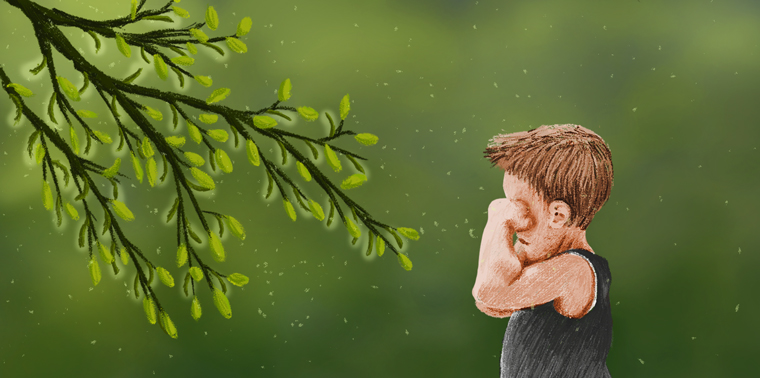February 13, 2018 — Both allergy and asthma are epidemic in many urban environments. Asthma, once rare, is now one of the most common chronic childhood diseases in Canada, Australia, the UK and the U.S. In the U.S. today, an estimated 30 percent of adults and 40 percent of children suffer from allergies. Studies show that allergies lower the test scores of schoolchildren. Worldwide, some 250,000 people die from asthma each year.
Experts suggest links to a number of modern trends: too much time indoors with electronic gadgets, too much junk food, not enough exercise, overly clean homes, overuse of antibacterial soaps.
Much less well known is the role of highly allergenic trees and shrubs we are planting with abandon in our yards and along our city streets.
Litter-Free, Allergen-Rich
Many species of trees and shrubs used in modern city landscapes are dioecious, meaning that individual plants are either male or female. In my experience, horticulturists almost always grow these plants as males. And many species that have both male and female flowers on the same plant are propagated only from all-male branches. Even with street trees that still have flowers of both sexes, the modern trend is toward selecting trees that are more male and less female.
When there are so many males and so few females, the pollen ends up instead in our eyes, on our skin and, of course, up our noses.Male plants are preferred because they produce no fruit, no seed and no seedpods; hence they are seen as low-maintenance, or “litter free.” But although they may not shed seeds, they do produce amazing amounts of pollen (one male maple tree might shed more than a 100 billion grains). Normally, female flowers catch and trap pollen, removing it from the air. But when there are so many males and so few females, the pollen ends up instead in our eyes, on our skin and, of course, up our noses.
Allergy and allergic asthma can be triggered by many different things, but the most common allergen is pollen. And pollen allergy is often a pre-condition for the development of asthma. Often the triggering event is a large, heavy exposure. As with so many things, if the dose is too large, problems occur.
A few examples:
- In Las Vegas, Nevada, more than 200,000 male mulberries were planted in the 1950s through 1990s. In 2005, these trees contributed to the highest official pollen count ever recorded in the U.S.: 69,224 airborne grains of pollen per cubic meter (1.3 cubic yards) of air, measured on the grounds of an elementary school. (It only takes around 20 to 30 grains per cubic meter to trigger allergies.)
- In Vancouver, Canada, almost every Manitoba maple tree planted is male. More than 90 percent of the yews there are male, and almost 100 percent of all the planted ash, willow and poplars are now male.
- In California, virtually 100 percent of one of the most common landscape trees/shrubs, shiny xylosma, are male clones.
- In most cities in the western U.S., almost all the junipers, willows and cottonwoods planted are male clones.
What to Do?
A few smart communities have decided to fight back: the counties that are home to Tucson and Las Vegas are among those that have enacted pollen-control ordinances that ban the sale or planting of some pollen-producing trees. But this is not enough.
If you have allergies, I encourage you to stand up for your right to breathe clean air. If you have allergies, I encourage you to stand up for your right to breathe clean air. To those without allergies, I advocate considerate landscaping: What you plant might well affect your neighbors, or kids who play in your yards. To those who plan and plant parks, how about allergy-friendly parks? For home builders, why not make all your new housing developments allergy-friendly?
Large tree growers, for their part, should produce and sell many more allergy-free female trees and other allergy-friendly plants. State legislatures should require retail nurseries to label trees and shrubs with their allergy potential. Many more cities should develop their own pollen-control measures (a simple plant-allergy scale I developed offers ready guidance). Schools in particular should clean up their schoolyards, and replace all of their most allergenic plants with allergy-free substitutes. Universities should train horticulture students so they understand the issue and are able to assess and manage allergy landscapes.
The costs to individual people and to society at large from all these increases in asthma and allergy are huge, and the problem continues to get worse. The millions of people suffering with allergies and asthma deserve far better than they’ve been getting. Let’s make sure they get it. ![]()
Editor’s note: The views expressed here are those of the author and not necessarily of Ensia. We present them to further discussion around important topics. We encourage you to respond with a comment below, following our commenting guidelines, which can be found on this page. In addition, you might consider submitting a Voices piece of your own. See Ensia’s Contact page for submission guidelines.
Ensia shares solutions-focused stories free of charge through our online magazine and partner media. That means audiences around the world have ready access to stories that can — and do — help them shape a better future. If you value our work, please show your support today.
Yes, I'll support Ensia!

I'd add that leaf blowers directed at the ground cast heavier pollens back into the air, in addition to molds, toxins, and particulates that would normally stay on the ground.
Our obsession with "neatness" is killing us.